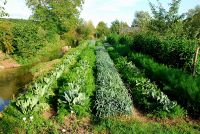 No tillage, plant cover, rotations, biomass, living soil, agroforestry, dynamic rotational grazing, soil fertility, crop association
No tillage, plant cover, rotations, biomass, living soil, agroforestry, dynamic rotational grazing, soil fertility, crop association

Agro-Eco-Logy : Is an agriculture that studies and uses soil (fields), as a house hosting a large number of living beings able to let plants grow on their own.
Principles

- Permanent occupation of land and space by plants and animals.
- Recycle all resources.
- Minimal environmental disturbance.
- Biodiversity and large number of actors.
- Information flow.
- Sharing abundance: Of products and services.
The aim is to copy nature, it grows all by itself!
Economic benefits

- Reduce production costs.
- Increase plant yield.
- Diversify income with, for example, agroforestry.
Environmental benefits

- Climate control.
- Depollution of water, air, soil.
- Fight against soil erosion.
- Healthy environment, plants, animals, people.
- Production of biodiversity.
- Reduction of resource consumption.
Social benefits

- Creation of fertile landscapes and opportunities for agritourism.
- Reduction of working time.
- Networking of farmers.
- Social recognition of our work.
- Better nutrition and health.
Concretely what is Agroecology?

Crops in living soil
- No tillage.
- Soil always covered.
- Maximized biomass production.
- Direct sowing under plant cover
- Cultivation in a permanent cover

Combining crops and livestock
- Fodder autonomy of farms.
- Dynamic rotating grazing / mob grazing.

Promote the water cycle
- Keyline design.
- Hill reservoir.
- Tree plantation.
- Vegetation continuity in dry period.

Include agroforestry in all systems
- Wood energy.
- Climate controller.
- Fodder agroforestry.
- Landscape designer.
- Economically profitable projects.
At home, in town and in schools
- Living soil vegetable gardening.
- Edible landscapes.
- Garden-forest.
- Productive lianas and trees to produce, air-condition, recycle and beautify.

Simply assess the fertility of your soil
- Slake test.
- Spade test.
- Evaluation of spontaneous biomass.
For more information on agroecology
Sources
- White paper from the Centre National d'Agroécologie. 2023.
This page has been written in partnership with the Urbane project and with the financial support of the European Union.


